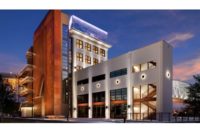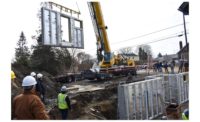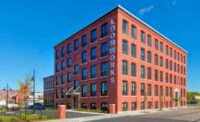| The Homes at Old Colony, Phase One |
| Submitted by: The Architectural Team (www.architecturalteam.com) |
| Date Completed: January 2012 |
| Size: 147,000 square feet |
| Location: South Boston, Mass. |
| Cost: $56.4 million (includes demolition and abatement; and Learning Center) |
| Certifications/Awards: LEED for Homes Platinum (townhomes); LEED for Homes Platinum (midrise apartment building); LEED-NC Gold (The Learning Center); Enterprise Green Building Criteria; EPA ENERGY STAR; HUD Healthy Homes Guidelines |
Originally built in 1941, South Boston’s Old Colony is the oldest public housing development in the United States. The Architectural Team’s redevelopment has transformed what was once a symbol of urban decay into The Homes at Old Colony. The efforts taken on this 147,000-square-foot national model for sustainable multifamily design and successful community revitalization has earned the project EDC’s 2013 Excellence in Design award for Residential New Construction.
Phase One of The Homes at Old Colony, completed in December 2011, replaced seven dilapidated structures with 116 new multifamily units in four groups of townhouse buildings and a six-story midrise building. The project’s total cost was $56.4 million, but includes the demolition and abatement of the previous buildings. The design and planning reorganized and rebuilt the community as an affordable LEED-certified community of townhouses, midrise apartment buildings and a shared learning center—all with solar power and other green features. Through a partnership with a third-party solar company, photovoltaic systems have been installed on all new buildings; the partnership facilitated financing energy conservation and renewable energy generation normally out of reach for affordable housing developments.
A Cohesive Endeavor
Boston Housing Authority (BHA) began work in 2009 with Chan Krieger, NBBJ, to master plan the new community, locate new streets and identify building types and locations. The overarching goal was to create better cohesion between Old Colony and the surrounding neighborhood, which was previously obstructed by the unsightly urban block housing structures. The plan successfully knit the new development into the fabric of South Boston, reconnecting the neighborhood with the entire city and the waterfront.
BHA then engaged Beacon Communities Development and The Architectural Team to begin the Phase One design of Old Colony. Utilizing HUD grant money from American Recovery and Reinvestment Act (ARRA) stimulus funds for “environmentally sustainable public housing transformation,” the design team utilized proven methods for green building, incorporating good neighborhood design and planning principles. This enabled BHA and Beacon to replace badly distressed public housing with design and construction infused with energy-efficient technology and products. Combined with the bold master plan, The Homes at Old Colony have helped provide the vitality, rejuvenation and hope that sustain a healthier way to live, play and contribute to society as a whole—a collaborative effort resulting in a “collaborative community.”
|
Key Players: - Owner: Boston Housing Authority, Beacon Communities Development LLC - Architect of Record: The Architectural Team Inc. - Master Plan: NBBJ - General Contractor: Suffolk Construction - Structural Engineer: Odeh Engineers Inc. - Civil Engineer: H.W. Moore Associates Inc. - M/E/P Engineer: Peterson Engineering - Landscape Architect: Stantec - Environmental Consultant: New Ecology Inc. - Interior Design: Beacon Concepts |
|
Certifications - LEED Platinum for Homes (Townhomes) - LEED Platinum for Homes Midrise (Midrise apartment building) - LEED-NC Gold (The Learning Center) - Enterprise Green Building Criteria - EPA ENERGY STAR - HUD Healthy Homes Guidelines |
The master plan replaced the monotony of identical super-blocks of barrack-style housing with varied and rhythmic massings that form safe, pedestrian-friendly streets and access points. The plan also emphasizes three key areas of sustainability:
- Physical sustainability: healthy construction with a net-zero energy use goal;
- Affordability: maximizing the replacement of housing while reducing development and operational costs; and
- Community sustainability: promoting self-sufficiency by connecting residents easily to transportation, educational, economic, recreational and wellness opportunities.
Planning for the Environment
Darcy L. Jameson, development director, Beacon Communities Development, says the most rewarding aspect of the sustainable design process of The Homes at Old Colony was the green charette at the outset of the project. “In collaboration with Boston Housing Authority residents, the property management team and our design and construction team, we established our shared vision and priorities in creating this new community. The charette helped us balance upfront costs, long-term operational costs and responding to resident goals.”
In order to affect the latter, the plan included a LEED Gold certified, 10,000-square-foot Learning Center which houses social service programs intended to improve educational opportunities and offer economic independence for residents of all ages.
| Materials |
|
Flooring: Roppe Northern Timbers vinyl plank - Roppe Fiesta treads and risers - Toli Fasolplus - Toli Lightstone - Toli MT Saftey Sheet - Ceres Recycled Rubber - Ceres Classic Cork |
|
Ceiling: - Painted gypsum wallboard - ACT areas include Armstrong Dune, Optima, Ultima and Ceramaguard |
|
Wood: - Wood trim includes painted FSC-certified base |
|
Roofing: - Sarnafil Sikaplan 60 in white - Timberline Lifetime asphalt |
|
System and Appliances: - Lochinvar Knight condensing boilers - McQuay chiller - Lifebreathe HRV individual units - Annexair central ERV system - GE, Bosch ENERGY STAR appliances |
|
Insulation or ICFs: - Medium density spray foam within wall cavity and roof framing - 1” foil faced polyiso rigid foam continuous outside of sheathing - 3” high density spray foam continuous over exterior sheathing - Rigid foam at flat roof |
|
Paints and Wall Coverings: - Glidden Lifemaster/Ultrahide, no-VOC |
|
Energy Efficiency: - All buildings have PV systems installed on their roofs which provide power for common areas and site lighting. |
|
Plumbing Fixtures: - Grohe Eurosmart 1.0 gpm - Grohe Relexa 1.5 gpm - Grohe Eurosmart 1.5 gpm - Gerber Ultraflush 1 .1 gpf |
|
Landscaping: - Low-flow irrigation system - Draught-tolerant plantings - Native plantings - Ideal Aquabrick permeable paving |
Designated an “Environmental Justice Community” by the Commonwealth of Massachusetts Executive Office of Energy and Environmental Affairs, development of the new housing was based on equal protection of all citizens under “the principle that all people have the right to be protected from environmental pollution and to live in and enjoy a clean and healthy environment.” The Architectural Team’s design does more than just comply with this principle. The ambitious green-building and energy-efficiency measures incorporated into The Homes at Old Colony arguably make it one of the first affordable housing projects in the U.S. to meet major national criteria and certifications for sustainability.
“The biggest challenge was how to balance the project’s high sustainability goals while using good quality, durable materials and keeping the overall project within budget,” says Jay Szymanski, AIA, LEED AP, associate, senior project manager, The Architectural Team. “Having the sustainability goals set from day one allowed the green features to be incorporated through the normal design process from initially siting buildings to take advantage of the southern solar exposure to the design of very efficient thermal envelopes.”
Phase One achieved LEED Platinum for Homes and LEED Platinum for Homes Midrise while also meeting Enterprise Green Building Criteria, EPA ENERGY STAR requirements and HUD Healthy Homes Guidelines. The learning center has received LEED Gold. Additionally, the master plan is designed to qualify for certification under LEED for Neighborhood Development.
The Architectural Team worked closely with Beacon Concepts to select all of the interior finishes while keeping in mind availability, durability, recycled content and aesthetics. The result is healthy, affordable, energy-efficient homes for the families living there. Green design elements include zero-VOC interior paints, low-flow faucets and valves, air-cooled chillers and resilient flooring made from recycled content.
Energy-efficient features include condensing boilers, heat and energy recovery ventilation units, vertical fan coil units, ENERGY STAR appliances, continuous spray foam/rigid foam insulation, and white “cool” roofing (for flat roof applications). In addition, the landscaping features low-flow irrigation, drought-tolerant plantings, native plantings, permeable paving and stormwater retention and diversion strategies.
“While many of the project’s most sustainable features such as insulation and mechanical systems are not visible, my favorite aspects of the project are ones where sustainable design directly informs the architecture,” says Edward Bradford, AIA, LEED AP, associate project architect. “The profile of the townhome buildings, for example, is shaped to maximize passive solar performance. Each unit, regardless of block orientation, includes sections of south-facing roof, angled to optimize solar gain for PV panels, with deep overhangs to prevent overheating. The unique and varied roof shapes also enliven the architecture while complimenting residential buildings in the surrounding neighborhood.”
|
KEY METRICS Building A, the midrise apartment building, scores a 32.2 percent reduction in energy cost based on ASHRAE 90.1-2007 modeling. The townhome units range in ENERGY STAR HERS scores from no higher than 48 to as low as 27. Total annual electricity produced by all photovoltaics on Phase One: 153,414 kWh |
Hear the interview with some members of The Architectural Team.
The above information was provided by The Architectural Team. For more information on EDC’s Excellence in Design Awards Contest, please visit EID.EDCmag.com.
The Excellence in Design Award case study featuring the category of Residential Renovation/Remodel has been moved to the November 2013 issue.
Residential New Construction Honorable Mentions
|
Cedar Gateway Submitted By: ROEM Corporation Size: Residential: 62,660 square feet; Retail: 4,342 square feet Location: San Diego, Calif. |
 Cedar Gateway is an affordable housing community in San Diego that achieved LEED Platinum certification. The project site overlooks Cortez Hill allowing tenants to enjoy the city. Cedar Gateway is designed to exceed Title-24 standard by 34.7 percent, and it implemented an irrigation system that reduces water flow rates of fixtures to environmentally sustainable levels. The project diverted more than 65 percent of construction waste from landfills by recycling construction materials such as wood, metal, drywall and concrete. Cedar Gateway serves as an important example of how properly planned and implemented redevelopment can transform neighborhoods and their residents. Cedar Gateway is an affordable housing community in San Diego that achieved LEED Platinum certification. The project site overlooks Cortez Hill allowing tenants to enjoy the city. Cedar Gateway is designed to exceed Title-24 standard by 34.7 percent, and it implemented an irrigation system that reduces water flow rates of fixtures to environmentally sustainable levels. The project diverted more than 65 percent of construction waste from landfills by recycling construction materials such as wood, metal, drywall and concrete. Cedar Gateway serves as an important example of how properly planned and implemented redevelopment can transform neighborhoods and their residents.Image by Jim Doyle, Applied Photography |
|
Fourth Street Family Apartments Submitted By: First Community Housing Size: 159,264 square feet Location: San Jose, Calif. |
 Fourth Street Family Apartments, located in downtown San Jose, earned LEED for Homes Midrise Platinum certification and provides affordable rental housing for low-income individuals earning 30 to 60 percent of the area median income. The property’s maintenance team has been trained in the sustainable operation of the building, and each household received a green building orientation tour and educational “Green Residental Manual” prior to moving in. A key feature was a LEED Innovation credit for avoidance of toxic chemicals. FCH has begun a fruit tree program at the property where any resident who wants to care for and maintain an apple, cherry, peach or nectarine tree is provided one free of charge. Fourth Street Family Apartments, located in downtown San Jose, earned LEED for Homes Midrise Platinum certification and provides affordable rental housing for low-income individuals earning 30 to 60 percent of the area median income. The property’s maintenance team has been trained in the sustainable operation of the building, and each household received a green building orientation tour and educational “Green Residental Manual” prior to moving in. A key feature was a LEED Innovation credit for avoidance of toxic chemicals. FCH has begun a fruit tree program at the property where any resident who wants to care for and maintain an apple, cherry, peach or nectarine tree is provided one free of charge. Image by Bernard Andre |
|
Richardson Residence Submitted By: Arkin Tilt Architects Size: 2,618 square feet Location: Palo Alto, Calif. |
 The Richardson Residence is carefully sited and detailed to maximize the experience of the semi-rural site while remaining comfortable year round. Surface water from the upper site is collected in a planted rill, routed under a bridge between living space and office to a swale below the house; this swale becomes a feature along the entry path. Balancing passive and active solar features, the roof of the bedroom wing lifts to the south with a dormer to the north for balanced light and solar hot water, and the roof of the northern wing lifts to the north providing south-facing slope for photovoltaics and pool solar heating balanced by a large dormer to the south at the living/dining space. The Richardson Residence is carefully sited and detailed to maximize the experience of the semi-rural site while remaining comfortable year round. Surface water from the upper site is collected in a planted rill, routed under a bridge between living space and office to a swale below the house; this swale becomes a feature along the entry path. Balancing passive and active solar features, the roof of the bedroom wing lifts to the south with a dormer to the north for balanced light and solar hot water, and the roof of the northern wing lifts to the north providing south-facing slope for photovoltaics and pool solar heating balanced by a large dormer to the south at the living/dining space. Image courtesy of Richardson Residence |











Report Abusive Comment